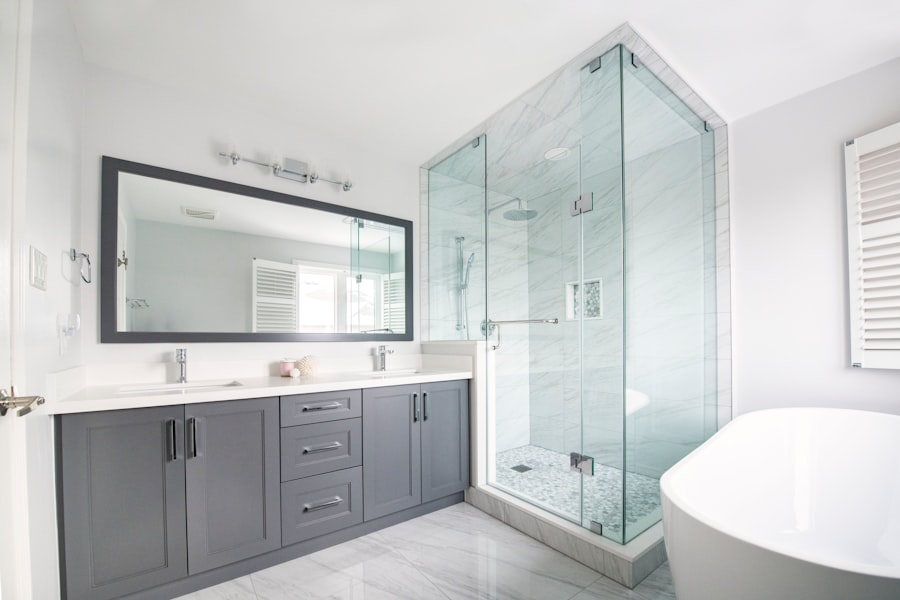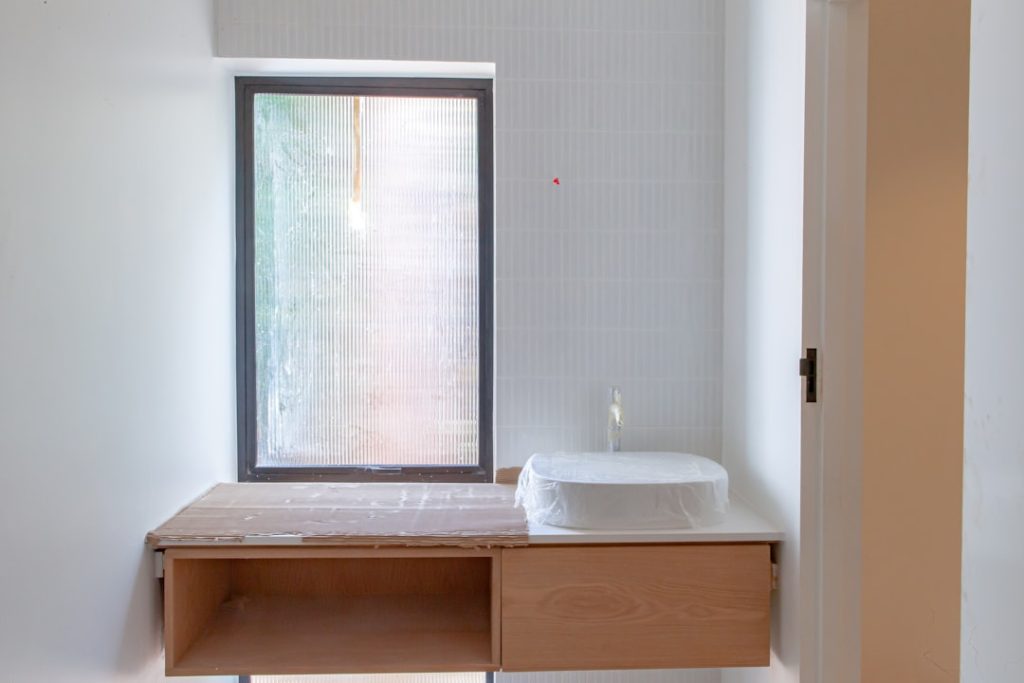Remodeling a bathroom is a significant investment that can enhance both the functionality and aesthetic appeal of your home. The average cost to remodel a bathroom varies widely based on several factors, including the size of the space, the extent of the renovation, and the materials used. On average, homeowners can expect to spend between $10,000 and $25,000 for a full bathroom remodel.
This range encompasses everything from minor updates, such as new fixtures and paint, to complete overhauls that involve changing the layout, plumbing, and electrical systems. In larger metropolitan areas or regions with a higher cost of living, the expenses can escalate even further. For instance, in cities like San Francisco or New York, a mid-range bathroom remodel can easily exceed $30,000.
Conversely, in smaller towns or rural areas, it may be possible to achieve a satisfactory remodel for as little as $5,000 to $10,000. Understanding these averages is crucial for homeowners as it sets a baseline for what they might expect to invest in their project.
Key Takeaways
- Bathroom remodel costs vary widely based on scope, materials, and labor.
- Key cost factors include size, fixtures, design complexity, and location.
- Establishing a realistic budget helps manage expenses and expectations.
- Choosing between a professional contractor and DIY impacts cost and quality.
- Planning ahead and considering hidden costs can prevent budget overruns.
Factors that Influence the Cost of Bathroom Remodeling
Several key factors play a pivotal role in determining the overall cost of a bathroom remodel. One of the most significant is the size of the bathroom itself. A larger bathroom typically requires more materials and labor, which can drive up costs.
For example, a small powder room may only need new fixtures and paint, while a spacious master bath might require extensive plumbing work, custom cabinetry, and high-end finishes. Another critical factor is the scope of the renovation. A cosmetic update—such as replacing countertops, sinks, and faucets—will generally be less expensive than a full remodel that involves relocating plumbing or electrical systems.
Homeowners should also consider whether they want to make structural changes, such as adding a shower or tub where none existed before. These alterations can significantly increase labor costs and require permits, further impacting the budget.
Setting a Realistic Budget for Your Bathroom Remodel

Establishing a realistic budget is essential for any successful bathroom remodel. Homeowners should begin by determining their priorities: what aspects of the bathroom are most important to them? Is it the aesthetics, functionality, or perhaps energy efficiency?
Once these priorities are established, it becomes easier to allocate funds accordingly. For instance, if high-quality fixtures are a priority, it may be necessary to cut back on other areas such as tile selection or cabinetry. It’s also wise to include a contingency fund in your budget—typically around 10% to 20% of the total estimated cost—to account for unexpected expenses that may arise during the remodeling process.
This could include discovering water damage behind walls or needing to upgrade electrical systems to meet current codes. By planning for these contingencies upfront, homeowners can avoid financial strain and ensure that their project stays on track.
When it comes to bathroom remodeling, homeowners often face the decision of whether to hire a professional contractor or tackle the project themselves. Hiring a contractor can provide numerous benefits, including access to their expertise and experience in managing complex renovations. Professionals are familiar with local building codes and regulations, which can help avoid costly mistakes or delays due to permit issues.
Additionally, contractors often have established relationships with suppliers and subcontractors, which can lead to better pricing on materials and labor. On the other hand, DIY remodeling can be an appealing option for those looking to save money or who enjoy hands-on projects. However, it’s essential to realistically assess one’s skills and experience before embarking on such an endeavor.
While minor updates like painting or replacing fixtures may be manageable for most homeowners, more complex tasks such as plumbing or electrical work require specialized knowledge and tools. Mistakes in these areas can lead to significant safety hazards and costly repairs down the line.
Hidden Costs to Consider When Remodeling a Bathroom
| Hidden Cost | Description | Estimated Impact | Notes |
|---|---|---|---|
| Structural Repairs | Fixing damaged subfloor, walls, or plumbing behind walls | High | Often discovered after demolition |
| Permits and Inspections | Required legal approvals and inspections for remodeling | Medium | Varies by location and project scope |
| Upgrading Plumbing or Electrical | Replacing outdated pipes or wiring to meet code | Medium to High | May require licensed professionals |
| Waterproofing | Additional layers to prevent water damage | Medium | Essential for showers and wet areas |
| Disposal Fees | Cost to remove old fixtures and debris | Low to Medium | Depends on volume and local regulations |
| Design Changes | Adjustments made during the project | Variable | Can increase costs significantly |
| Temporary Bathroom Setup | Alternative facilities during remodel | Low to Medium | Important for households with one bathroom |
| Hidden Mold or Mildew | Remediation of unseen water damage | Medium to High | Health risk and costly to fix |
| Material Waste | Extra materials needed due to mistakes or cuts | Low to Medium | Plan for 10-15% overage |
| Increased Utility Costs | Higher water or electricity use from new fixtures | Low | Consider energy-efficient options |
While many homeowners focus on visible expenses like tiles and fixtures when budgeting for a bathroom remodel, hidden costs can quickly add up and derail financial plans. One common hidden cost is related to plumbing and electrical work. If existing systems are outdated or not up to code, they may need to be upgraded or replaced entirely.
This can involve additional labor costs and materials that were not initially accounted for in the budget. Another often-overlooked expense is the cost of permits and inspections. Many municipalities require permits for significant renovations, especially those involving plumbing or electrical changes.
Failing to obtain these permits can result in fines or complications when selling the home in the future. Additionally, homeowners should consider costs associated with temporary living arrangements if the bathroom is out of commission for an extended period during renovations.
Tips for Saving Money on Your Bathroom Remodel
There are several strategies homeowners can employ to save money on their bathroom remodel without sacrificing quality or aesthetics. One effective approach is to focus on cosmetic changes rather than structural ones. For example, instead of moving plumbing fixtures around, consider keeping them in their current locations while updating surrounding elements like cabinetry and countertops.
This can significantly reduce labor costs associated with plumbing work. Another way to save is by shopping smart for materials. Homeowners can explore options such as discount retailers or online marketplaces that offer high-quality products at lower prices.
Additionally, considering alternative materials—like laminate instead of solid wood for cabinetry—can provide substantial savings while still achieving an attractive look. Finally, timing can also play a role; scheduling renovations during off-peak seasons may lead to lower labor costs as contractors may offer discounts during slower periods.
The Importance of Quality Materials in Bathroom Remodeling

Investing in quality materials is crucial when remodeling a bathroom, as this space is subject to high levels of moisture and wear over time. Choosing durable materials not only enhances the longevity of the remodel but also contributes to overall home value. For instance, opting for porcelain tiles instead of cheaper ceramic options can provide better resistance to water damage and staining while offering a more upscale appearance.
Moreover, high-quality fixtures—such as faucets and showerheads—can improve both functionality and aesthetics. While they may come with a higher upfront cost, quality fixtures often come with warranties and require less maintenance over time. This investment pays off in terms of performance and durability, ultimately leading to lower replacement costs in the future.
How to Plan for a Successful Bathroom Remodel
Planning is key to executing a successful bathroom remodel that meets both aesthetic desires and functional needs. The first step in this process is creating a detailed design plan that outlines all aspects of the renovation—from layout changes to material selections. Utilizing design software or consulting with an interior designer can help visualize how different elements will work together in the space.
Once a design plan is established, it’s essential to create a timeline that outlines each phase of the project. This includes scheduling when materials will be ordered and delivered, when demolition will occur, and when installation will take place. Clear communication with contractors or team members involved in the project is vital throughout this process to ensure everyone is aligned on expectations and deadlines.
Additionally, homeowners should consider how their daily routines will be affected during the remodel. Planning for alternative arrangements—such as using another bathroom or setting up temporary facilities—can help minimize disruptions during construction. By taking these steps and remaining organized throughout the process, homeowners can achieve a successful bathroom remodel that enhances their living space while staying within budgetary constraints.




